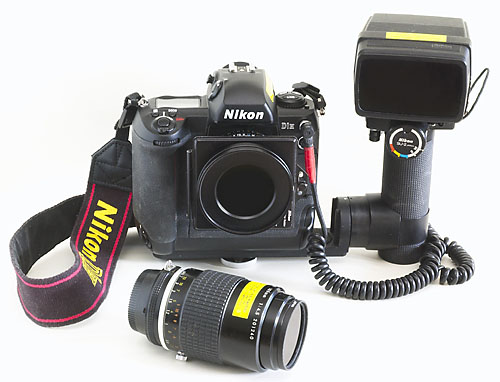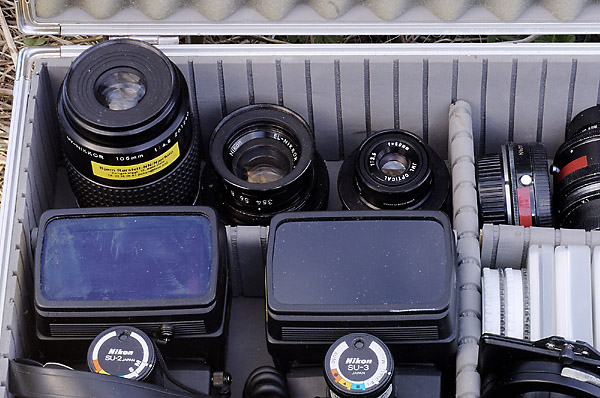| All You Ever Wanted to Know About Digital UV and IR Photography, But Could Not Afford to Ask | |
| All You Ever Wanted to Know About Digital UV and IR Photography, But Could Not Afford to Ask | |
7. Which Lenses?
Without photographic lenses, we're pretty much lost in our endeavours towards capturing the invisible light (on a tangent note, there always is the possibility of doing pinhole photography). Fortunately, specialised lenses are rarely needed for pictorial UV or IR photography, as you'll learn in the following sections.
Infrared
(IR):
Virtually any lens can be
used for IR photography, provide you can attach the needed black
IR filter onto the lens (front or rear). You can employ zoom
lenses although I would recommend using fixed focal length lenses
because they tend to have smaller filter threads and hence need
smaller and less expensive filters. If you apply the inside trick
of making an IR-filter by using pieces of black, processed E-6
film, any lens will do.
There will be a degradation of optical quality for most lenses when they are pressed into service for recording IR, but this should not be a critical issue unless you are a real nit-picker (who won't dare to experiment anyway). Likely there will be increased chromatic and spherical aberrations, and a significant shift of focus. Thus, you should always try to stop down the lens because this reduced optical aberrations, and the increased depth-of-field will mask focusing inaccuracy. A rule-of-thumb is to increase lens extension by 10% which is easy to do using bellows for close-ups, but less easy implemented for landscape work. If there is a red IR index on your lens, use it to realign focus before shooting. If the index dot is missing, just focus well in front of the closest subject of interest. For a 28 mm wide-angle lens, a focus setting around 2-5 m will be adequate for distant landscape shooting in IR.
I have had very deviating results from mirror lenses as far as IR performance is concerned. Some copes very well with IR (Itorex 300 mm f/5.6 is an example), whilst other exhibit appalling images in IR (B.I.G. 500 mm f/5.6).
Ultra-violet
(UV):
Optical glass
don't transmit much UV, and the modern multi-coated lenses pass
even less. However, although this may sound ominous, don't give
up. One has to understand that the UV range of interest to the
scientific community more often than not is different from the
range useful for pictorial UV photography. If long-range UV-A
(between 350 and 400 nm) suffices, so will some lenses. You expressedly don't need a horrendously
expensive quartz/fluorite lens to do UV work with a digital SLR.
I should know, I've tried it (and I own the fabulous UV-Nikkor
105 mm lens so can compare). On the other hand, if you want to
record UV shorter than 350 nm, only quartz lenses will be
satisfactory. Besides second-hand and expensive UV-Nikkors, there
is a new UV 105 mm lens available from Coastal
Optics. However, even this
won't come cheap. You are herewith warned.
However, although "ordinary" lenses can be used for pictorial UV, most are unsuited for this line of photography. Since digital cameras aren't very sensitive to UV, you need to stack the odds in your favour if pleasing UV images are to be obtained, and you need using the best lens for the job. A UV-Nikkor isn't for everyone, but there are feasible alternatives. The important criteria for a suitable lens (unless you possess a dedicated UV lens, of course) are as follows,
A simple optical design with few lens elements. The fewer the better
No cemented elements should occur
No multi-coating on the lens
Cheap to purchase because you need to modify the lens (see below)
In the Nikon lens
line, there are several candidates which comply with all
criteria. These are the Nikon Series E lenses, viz. 28 mm f/2.8
E, 35 mm f/2.5 E, and 100 mm f/2.8 E, all of which are simple 4-
or 5-element designs. They have low status, are produced in high
numbers so should be easy to locate even today, and can be
obtained dirt cheap. This is all well because you need to treat
them in a harsh way unheard of for your ordinary lenses. The lens coating on the
front and rear elements should be removed! You are a dedicated UV enthusiast, aren't you? Oh
well.
|
Rough trade, or homework for the UV enthusiast A Nikon Series E lens has a simplified lens coating, but will yield much better results for UV if you remove the coating. An old T-shirt, plenty of abrasive polishing cream, and infinite patience, are all you need for this intrepid task. Put your favourite CD on the stereo and grind way. Ensure you have actived "repeat" mode on the player simultaneously. At least you'll realise just how hard and scratch-resistant lens coatings are. For UV-enthusiasts without the patience, an electric drill can speed up the polishing task immensely. |
Enlarger lenses pass more UV than camera lenses and can be
deployed on bellows for UV work. If you put a 105 mm enlarger
lens on a bellows, chances are you can focus towards infinity
with it. Other candidates would be fax lenses lifted off wrecked
copiers, apochromatic process lenses, or even mirror lenses. Be
aware that some mirror lenses, despite not giving focus shifts,
perform very poorly in UV, because of the refractive optics in
their design. You have to try this to find out whether or not
your mirror lens is a candidate for UV photography.
I recently acquired a EL-Nikkor 63 mm f/3.5 lens, which has a specified flat spectral response in UV down to at least 350 nm, well into the UV range (the UV-Nikkor responds down to 200 nm, so is in a class of its own). The nice thing about the EL 63, besides it being small and neat, is that it will focus to infinity on most cameras and can be applied to film as well as digital systems. With assistance of my inventive friend, Are Hodne, we managed to mount the EL-Nikkor in a focusing mount so I now can use it as any other lens on my Nikons. The focusing mount by the way was conjured up from an old Canon M15-25 focusing extension tube, so never throw away parts which may prove useful later on. A bit longer in focal reach, the 160 mm f/5.6 FAX-Nikkor complements the EL-Nikkor and has about the equal UV response.
Sometimes, you get pleasant surprises. Thus, an extremely cheap enlarger lens, JML 50 mm f/3.5, purchased for a few dollars from the surplus stocks of an eBay seller, gives nicely defined UV images. It can be made to focus to infinity on modern cameras, but due to its very simple triplet design, you get lots of optical aberrations in addition to infinity focus. Restrict it to the near range or for close-ups, and results are surprisingly good.
For any lenses, except for the UV-Nikkor and similar quartz-based lenses together with the 63 mm EL-Nikkor, a significant shift of focus is probably occuring when you shoot with it in UV. My experience is that this shift occurs approximately as with IR, thus you need to focus the lens closer than for visual photography. Also expect a significant degradation of the optical quality rendered, because the lenses are not designed to cope with UV rays and hence there will be plenty of residual optical aberrations. I've done a fair amount of UV shooting with the Nikon 28 and 35 mm Series E lenses, and the 35 mm f/2.5 SE is by far the better UV performer of these.
Stopping down the lens helps mitigate the off-focus problem, and stop worrying about the issue helps even more. Who said UV photography should equal visual-light photography? Learn instead to use the inherent diffuse nature of the UV light field, and the concurrent soft rendition of UV images, to enhance your pictorial results.
 |
The Left-hand Side of Darkness A Nikon D1H, outfitted with a Nikon 28 mm f/2.8 Series E lens and my former standard filter pack for UV, Nikon FF + Wratten CC20C. An SB-140 flash and the UV-Nikkor 105 mm f/4.5 lens with its black Hoya U-360 filter in front complete the sombre look. |
For my trips of UV- and IR-photography, I found it convenient to put all the odd bits and pieces needed into a sturdy field case. Having everything in one place simplifies work and allows for more planned experimental photography as well.
 |
Well Endowed A look into a corner of my UV/IR photography field case. In the back, my three main lenses for UV work, from left to right these are UV-Nikkor 105 mm f/4.5, El-Nikkor 63 mm f/3.5 in its focusing mount (with CPU in it) to give infinity focus, and finally, the tiny JML 50 mm f/3.5 lens used for overviews of smaller areas.To complement these lenses, a number of CPU-modified extension rings and bellows are ready at hand. To the front, the dark flash heads belong to the UV-flash SB-140 (left) with the SW5-UV filter on it, and besides that elusive item, the more common relative, SB-14 with the SW5-IR filter, the latter flash is used mainly for IR work. Both share my two SD-7 power packs. A wide range of UV bandpass filters (Hoya U-330, U-340, U-360; B+W 403; Nikon FF) are readily avaliable for use in Nikon AF-1 holders outfitted with the UR-2 adapter. An IR blocking filter, mainly B+W BG-38, is routinely used in conjunction with the UV bandpass filters to abate IR contamination of the UV image. For IR work, I stock plenty of Wratten filters (89B, 87, 87C) in gel or glass mount, together with the more exotic Hoya RM-90 and RM-100. The Wratten filters are also available for filter holders insertable in my long telephoto lenses. Now, all that remains is hauling the heavy case along with me on field trips, and remember which filter combinations are optimal for any given shooting session ... To exacerbate the situation, I've now added a 160 mm f/5.6 FAX-Nikkor to my UV lens arsenal. |